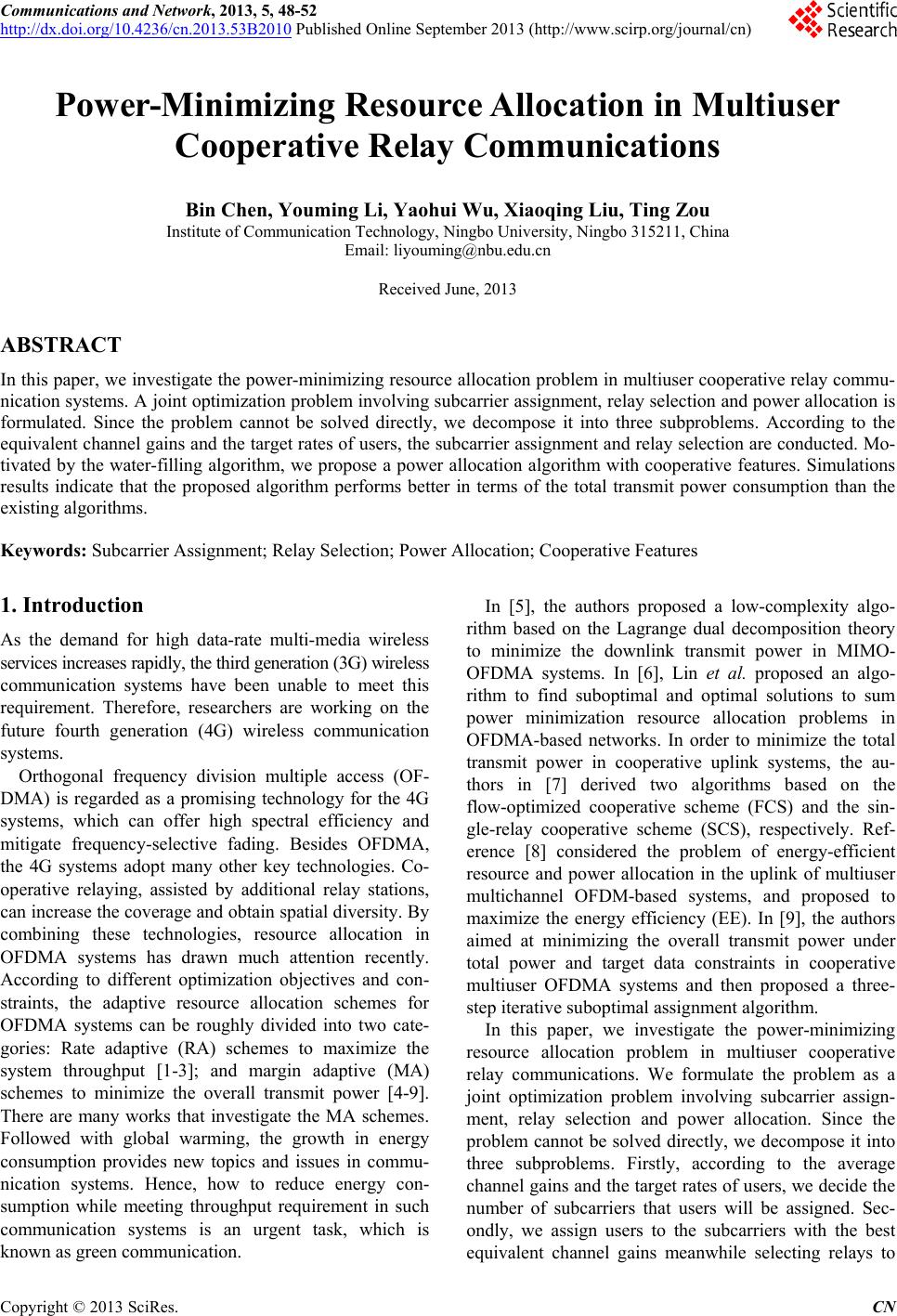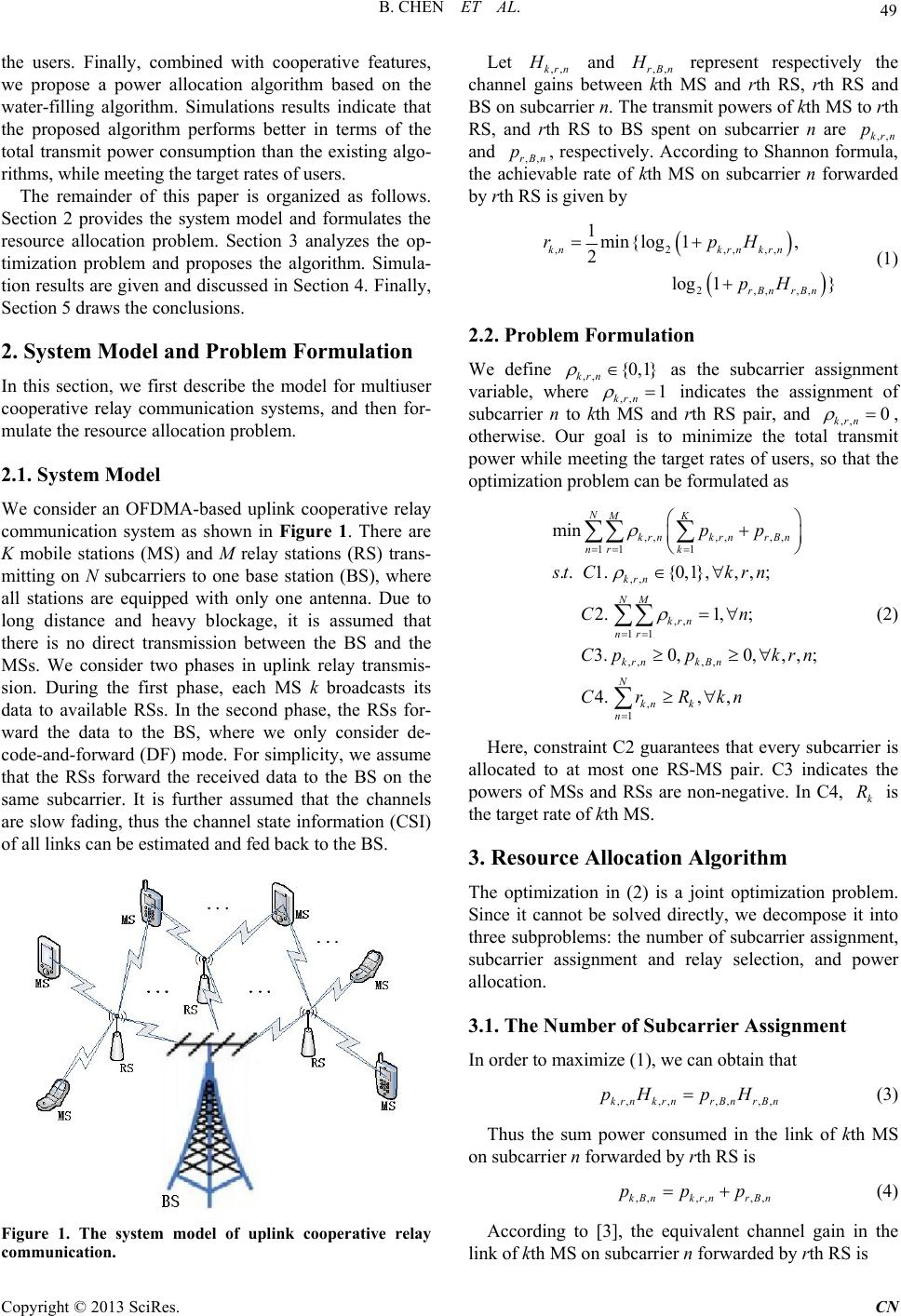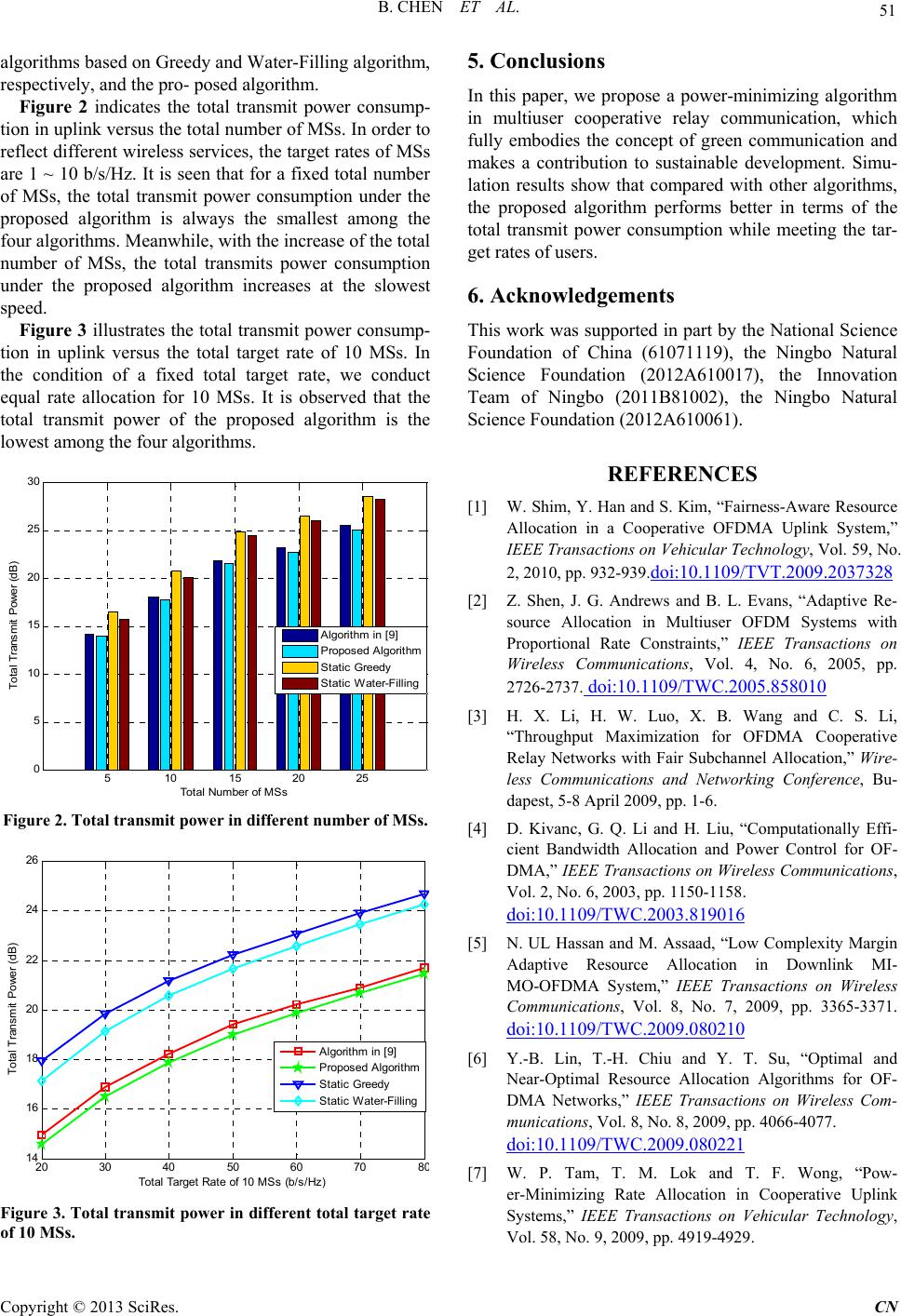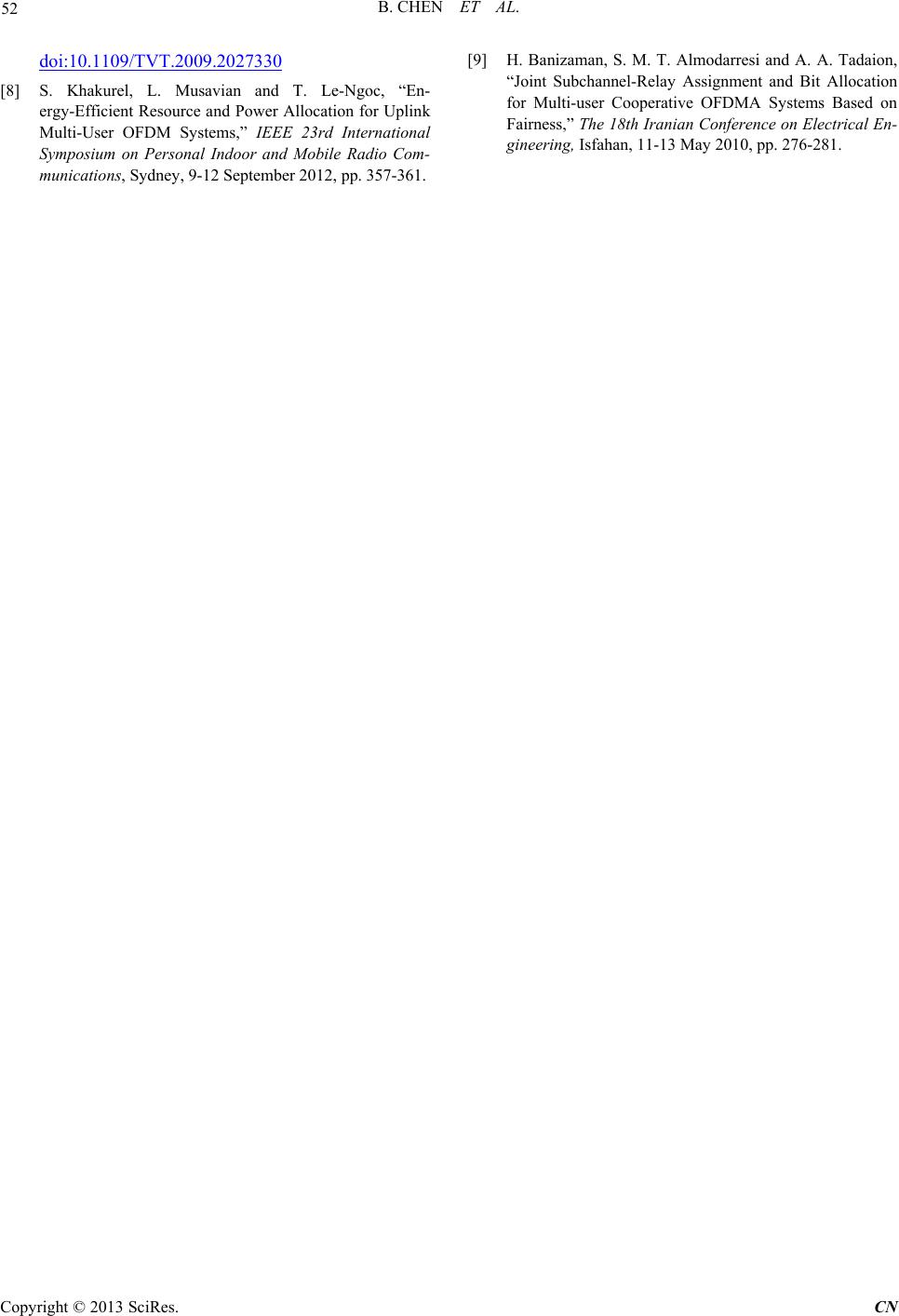 Communications and Network, 2013, 5, 48-52 http://dx.doi.org/10.4236/cn.2013.53B2010 Published Online September 2013 (http://www.scirp.org/journal/cn) Power-Minimizing Resource Allocation in Multiuser Cooperative Relay Communications Bin Chen, Youming Li, Yaohui Wu, Xiaoqing Liu, Ting Zou Institute of Communication Technology, Ningbo University, Ningbo 315211, China Email: liyouming@nbu.edu.cn Received June, 2013 ABSTRACT In this paper, we investigate the power-minimizing resource allocation problem in multiuser cooperative relay commu- nication systems. A joint optimization problem involving subcarrier assignment, relay selection and power allocation is formulated. Since the problem cannot be solved directly, we decompose it into three subproblems. According to the equivalent channel gains and the target rates of users, the subcarrier assignment and relay selection are conducted. Mo- tivated by the water-filling algorithm, we propose a power allocation algorithm with cooperative features. Simulations results indicate that the proposed algorithm performs better in terms of the total transmit power consumption than the existing algorithms. Keywords: Subcarrier Assignment; Relay Selection; Power Allocation; Cooperative Features 1. Introduction As the demand for high data-rate multi-media wireless services increases rapidly, the third generation (3G) wireless communication systems have been unable to meet this requirement. Therefore, researchers are working on the future fourth generation (4G) wireless communication systems. Orthogonal frequency division multiple access (OF- DMA) is regarded as a promising technology for the 4G systems, which can offer high spectral efficiency and mitigate frequency-selective fading. Besides OFDMA, the 4G systems adopt many other key technologies. Co- operative relaying, assisted by additional relay stations, can increase the coverage and obtain spatial diversity. By combining these technologies, resource allocation in OFDMA systems has drawn much attention recently. According to different optimization objectives and con- straints, the adaptive resource allocation schemes for OFDMA systems can be roughly divided into two cate- gories: Rate adaptive (RA) schemes to maximize the system throughput [1-3]; and margin adaptive (MA) schemes to minimize the overall transmit power [4-9]. There are many works that investigate the MA schemes. Followed with global warming, the growth in energy consumption provides new topics and issues in commu- nication systems. Hence, how to reduce energy con- sumption while meeting throughput requirement in such communication systems is an urgent task, which is known as green communication. In [5], the authors proposed a low-complexity algo- rithm based on the Lagrange dual decomposition theory to minimize the downlink transmit power in MIMO- OFDMA systems. In [6], Lin et al. proposed an algo- rithm to find suboptimal and optimal solutions to sum power minimization resource allocation problems in OFDMA-based networks. In order to minimize the total transmit power in cooperative uplink systems, the au- thors in [7] derived two algorithms based on the flow-optimized cooperative scheme (FCS) and the sin- gle-relay cooperative scheme (SCS), respectively. Ref- erence [8] considered the problem of energy-efficient resource and power allocation in the uplink of multiuser multichannel OFDM-based systems, and proposed to maximize the energy efficiency (EE). In [9], the authors aimed at minimizing the overall transmit power under total power and target data constraints in cooperative multiuser OFDMA systems and then proposed a three- step iterative subopti mal assignment algorithm. In this paper, we investigate the power-minimizing resource allocation problem in multiuser cooperative relay communications. We formulate the problem as a joint optimization problem involving subcarrier assign- ment, relay selection and power allocation. Since the problem cannot be solved directly, we decompose it into three subproblems. Firstly, according to the average channel gains and the target rates of users, we d ecide the number of subcarriers that users will be assigned. Sec- ondly, we assign users to the subcarriers with the best equivalent channel gains meanwhile selecting relays to C opyright © 2013 SciRes. CN  B. CHEN ET AL. 49 the users. Finally, combined with cooperative features, we propose a power allocation algorithm based on the water-filling algorithm. Simulations results indicate that the proposed algorithm performs better in terms of the total transmit power consumption than the existing algo- rithms, while meeting the target rates of users. The remainder of this paper is organized as follows. Section 2 provides the system model and formulates the resource allocation problem. Section 3 analyzes the op- timization problem and proposes the algorithm. Simula- tion results are given and discussed in Section 4. Finally, Section 5 draws the conclusio ns. 2. System Model and Problem Formulation In this section, we first describe the model for multiuser cooperative relay communication systems, and then for- mulate the resource allocatio n problem. 2.1. System Model We consider an OFDMA-based uplink cooperative relay communication system as shown in Figure 1. There are K mobile stations (MS) and M relay stations (RS) trans- mitting on N subcarriers to one base station (BS), where all stations are equipped with only one antenna. Due to long distance and heavy blockage, it is assumed that there is no direct transmission between the BS and the MSs. We consider two phases in uplink relay transmis- sion. During the first phase, each MS k broadcasts its data to available RSs. In the second phase, the RSs for- ward the data to the BS, where we only consider de- code-and-forward (DF) mode. For simplicity, we assume that the RSs forward the received data to the BS on the same subcarrier. It is further assumed that the channels are slow fading, thus the channel state information (CSI) of all links can be estimated and fed back to the BS. Figure 1. The system model of uplink cooperative relay communication. Let ,,krn and ,,rBn represent respectively the channel gains between kth MS and rth RS, rth RS and BS on subcarrier n. The transmit powers of kth MS to rth RS, and rth RS to BS spent on subcarrier n are ,,krn and ,,rBn, respectively. According to Shannon formula, the achievable rate of kth MS on subcarrier n forwarded by rth RS is given by H H p p ,2,,,, 2,,,, 1min{log 1, 2 log1} knkrn krn rBn rBn rpH pH (1) 2.2. Problem Formulation We define ,, {0,1} krn as the subcarrier assignment variable, where ,, 1 krn indicates the assignment of subcarrier n to kth MS and rth RS pair, and ,, 0 krn , otherwise. Our goal is to minimize the total transmit power while meeting the target rates of users, so that the optimization problem can be formulated as ,,,,, , 11 1 ,, ,, 11 ,,, , , 1 min .. 1. {0,1},,,; 2. 1,; 3. 0,0,,,; 4. ,, NMK krnkrn rBn nr k krn NM krn nr krn kBn N kn k n pp stCk r n Cn Cp pkrn CrRkn (2) Here, constraint C2 guarantees that every subcarrier is allocated to at most one RS-MS pair. C3 indicates the powers of MSs and RSs are non-negative. In C4, is the target rate of kth MS. k R 3. Resource Allocation Algorithm The optimization in (2) is a joint optimization problem. Since it cannot be solved directly, we decompose it into three subproblems: the number of subcarrier assignment, subcarrier assignment and relay selection, and power allocation. 3.1. The Number of Subcarrier Assignment In order to maximize (1), we can obtain that ,,,,,,,,krnkrnrBnrBn pH pH (3) Thus the sum power consumed in the link of kth MS on subcarrier n forwarded by rth RS is ,,,, ,,kBnkrn rBn ppp (4) According to [3], the equivalent channel gain in the link of kth MS on subcarrier n forwarded by rth RS is Copyright © 2013 SciRes. CN  B. CHEN ET AL. 50 ,,,,krn rBn equ HH H ,, ,,, , krn krn rBn HH(5) Consequently, Equation (1) can be rewritten as ,2,,, 1log 1 2 equ knkBnkrn rp , H (6) Based on [4], we assume that each MS k experiences an average channel gain on every subcarrier with ,, 11 NMequ krn nr k H HMN (7) Let MS k be allocated subcarriers. When the gain on k m sa each subcarrier is theme, the optimal rate-power allocation is to transmit kk Rm bits on each subcarrier, resulting in total transmi as t power 21 kk Rm kk mH. Thus in order to determine the nums assigned to each MS {,1,2,..., } k mk K ber of subcarrier , the objective function can be expressed as 1 1 max min(2 1) .. 1. , C2. ,...,, k k R Kmkm kk K k k k k H st CmN k R mNk B (8) where is the number of maximum modulation bit. 3.2. Subcarrier Assignment and Relay Selection e maximum equivalent channel gain for each M , (9) b) According to the average channel gain of each sub- ca max B According to equivalent channel gain, we should assign the better subcarriers to each MS. Becaus e every subcarr ier is allocated to at most one RS-MS pair, we propose an algorithm of subcarriers selecting users. The algorithm is as follows. a) Find th S on each subcarrier. H ,, 1 max equ kn krn rM H rrier , 1 K nkn k HK, arrange the channel gain ma- trix (,) N in increasing order. 12 (,),(... ) KN HHH (10) c) For each subcarrier, find the MS whos ga (11) where indicates the set of subcarriers is the number of elem ing lgorithm, we propose a power h also has cooperative features. s. e channel in is the largest on the subcarrier, then assign the sub- carrier to the MS. Detailed process is as follows. 1,2,...,for nNdo , 1 arg max kn kK kH , , 1 ,0 argmax {} 1 kk kn kn kK kk kk while cmdo Hn kH end while CCn cc end for {1,2,...,} k CN assigned to the kth MS, , ents in the set k C{1,2,...,N} k c . 3.3. Power Allocation Based on the water-fill a allocation algorithm, whic The algorithm is as follow a) Extract the channel gain of the subcarriers assigned to the MS from the channel gain matrix (,) N, and store them into a row vector {(,),hkmk. 1,2,..., }K k b) Arrange (, ) k hkm in decrease order. ,1 ( ,)[,,...,] kk hkmh hh ,2, ,1 ( k k km k h,2, ... ) k kkm hh 2) c) Compute the water-filling constant. (1 1 , 1, k MA km nkn Kh 2k km R (13) d) Test subcarrier energy. ,, 10 kk mMAkkm Kh (14) If yes, then 1 kk mm , go to step c), otherwise continue. f) Compute subcarrier energy and rate ,,, 1, 1,2,..., knkn kMAk hn m (15) ,2,, log (k knMAkkm bKh) (16) 4. Simulation Results and Analysis In this section, simulation results are provided to evaluate ency-selec- . The max- the system performance. Here, six-path frequ tive Rayleigh fading channels are considered imum Doppler shift is 30Hz. The total bandwidth is set to be 1MHz and the number of subcarriers is 256. Assume that the Gaussian white noise power spectral density is -36 dB/Hz and the number of maximum modulation bit is 4. The total power consumption of each power allocation scheme is averaged over 1,000 independent Monte-Carlo simulations. The performance comparison is conducted among the algorithm in [9], static resource allocation Copyright © 2013 SciRes. CN  B. CHEN ET AL. 51 algorithms based on Greedy and Water-Filling algorithm, respectively, and the pro- posed algorithm. Figure 2 indicates the total transmit power consump- tion in uplink versus the total number of MSs. In order to reflect different wireless services, the target rates of MSs ar dition of a fixed total target rate, we conduct eq e 1 ~ 10 b/s/Hz. It is seen that for a fixed total number of MSs, the total transmit power consumption under the proposed algorithm is always the smallest among the four algorithms. Meanwhile, with the increase of the total number of MSs, the total transmits power consumption under the proposed algorithm increases at the slowest speed. Figure 3 illustrates the total transmit power consump- tion in uplink versus the total target rate of 10 MSs. In the con ual rate allocation for 10 MSs. It is observed that the total transmit power of the proposed algorithm is the lowest among the four algorithms. 510 15 20 25 0 5 10 15 20 25 30 Total Number of MS s Total Transmi t Power (dB) Algorithm in [9] P roposed Al go rithm S t atic Greedy Static W ater-Filling Figure 2. Total transmit power in different number of MSs. 20 30 40 50 60 708 14 16 18 20 22 24 26 Total Target Rate of 10 MSs (b/s/Hz) Total Transmit P ower (dB) Algorithm in [9] P roposed Al gori thm S tatic G reedy Static Water-Filling Figure 3. Total transmit power in different total target rate of 10 MSs. In this paper, we propose a power-minimizing algorithm rative relay communication, which This work was supported in part by the National Science 1119), the Ningbo Natural [1] W. Shim, Y. Han and S. Kim, “Fairness-Aware Resource Allocation in Uplink System,” IEEE Transacology, Vol. 59, No. 5. Conclusions in multiuser coope fully embodies the concept of green communication and makes a contribution to sustainable development. Simu- lation results show that compared with other algorithms, the proposed algorithm performs better in terms of the total transmit power consumption while meeting the tar- get rates of users. 6. Acknowledgements Foundation of China (6107 Science Foundation (2012A610017), the Innovation Team of Ningbo (2011B81002), the Ningbo Natural Science Foundation (2012A610061). REFERENCES a Cooperative OFDMA tions on Vehicular Techn 2, 2010, pp. 932-939.doi:10.1109/TVT.20 09 .2037328 [2] Z. Shen, J. G. Andrews and B. L. Evans, “Adaptive Re- source Allocation in Multiuser OFDM Systems with Proportional Rate Constraints,” IEEE Transactions on Wireless Communications, Vol. 4, No. 6, 2005, pp. 2726-2737. doi:10.1109/TWC.2005.858010 [3] H. X. Li, H. W. Luo, X. B. Wang and C. S. Li, “Throughput Maximization for OFDMA Cooperative Relay Networks with Fair Subchannel Allocation,” Wire- reless Communications, less Communications and Networking Conference, Bu- dapest, 5-8 April 2009, pp. 1-6. [4] D. Kivanc, G. Q. Li and H. Liu, “Computationally Effi- cient Bandwidth Allocation and Power Control for OF- DMA,” IEEE Transactions on Wi Vol. 2, No. 6, 2003, pp. 1150-1158. doi:10.1109 /TWC.2003.819016 [5] N. UL Hassan and M. Assaad, “Low Complexity Margin Adaptive Resource Allocation in MO-OFDMA System,” IEEE Transa Downlink MI- ctions on Wireless Communications, Vol. 8, No. 7, 2009, pp. 3365-3371. doi:10.1109 /TWC.2009.080210 [6] Y.-B. Lin, T.-H. Chiu and Y. T. Su, “Optimal and Near-Optimal Resource Allocation Algorithms for OF- DMA Networks,” IEEE Transactions on Wireless Com- munications, Vol. 8, No. 8, 2009, pp. 4066-4077. doi:10.1109 /TWC.2009.080221 [7] W. P. Tam, T. M. Lok and T. F. Wong, “Pow- er-Minimizing Rate Allocation in Cooperative Systems,” IEEE Transactions on VeUplink hicular Technology, Vol. 58, No. 9, 2009, pp. 4919-4929. Copyright © 2013 SciRes. CN  B. CHEN ET AL. Copyright © 2013 SciRes. CN 52 doi:10.1109 /TVT.2009.2027330 [8] S. Khakurel, L. Musavian and T. Le-Ngoc, “En- ergy-Efficient Resource and Power A Multi-User OFDM Systems,” IEEE llocation for Uplink 23rd International for Symposium on Personal Indoor and Mobile Radio Com- munications, Sydney, 9-12 September 2012, pp. 357-361. [9] H. Banizaman, S. M. T. Almodarresi and A. A. Tadaion, “Joint Subchannel-Relay Assignment and Bit Allocation Multi-user Cooperative OFDMA Systems Based on Fairness,” The 18th Iranian Conference on Electrical En- gineering, Isfahan, 11-13 May 2010, pp. 276-281.
|